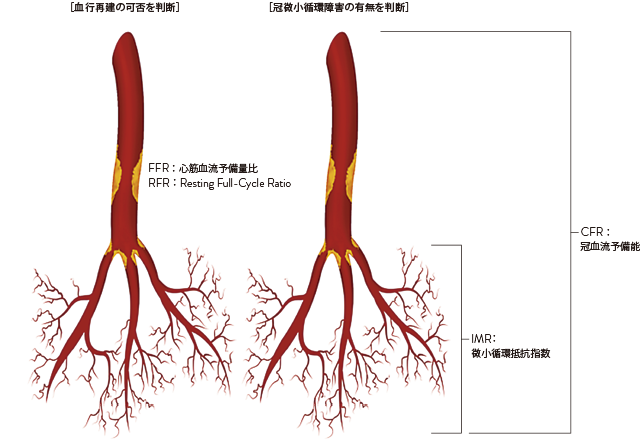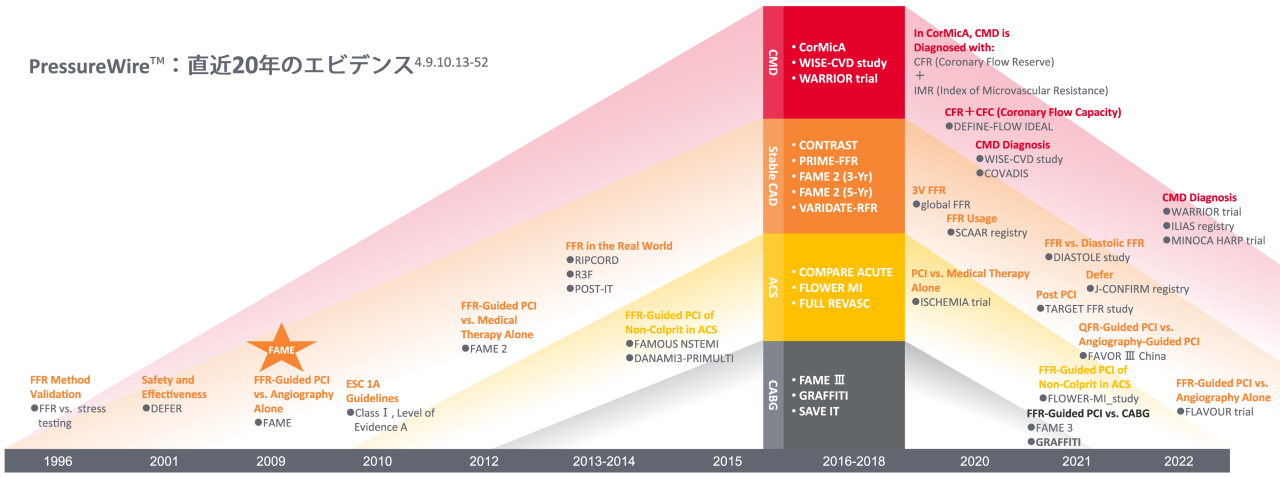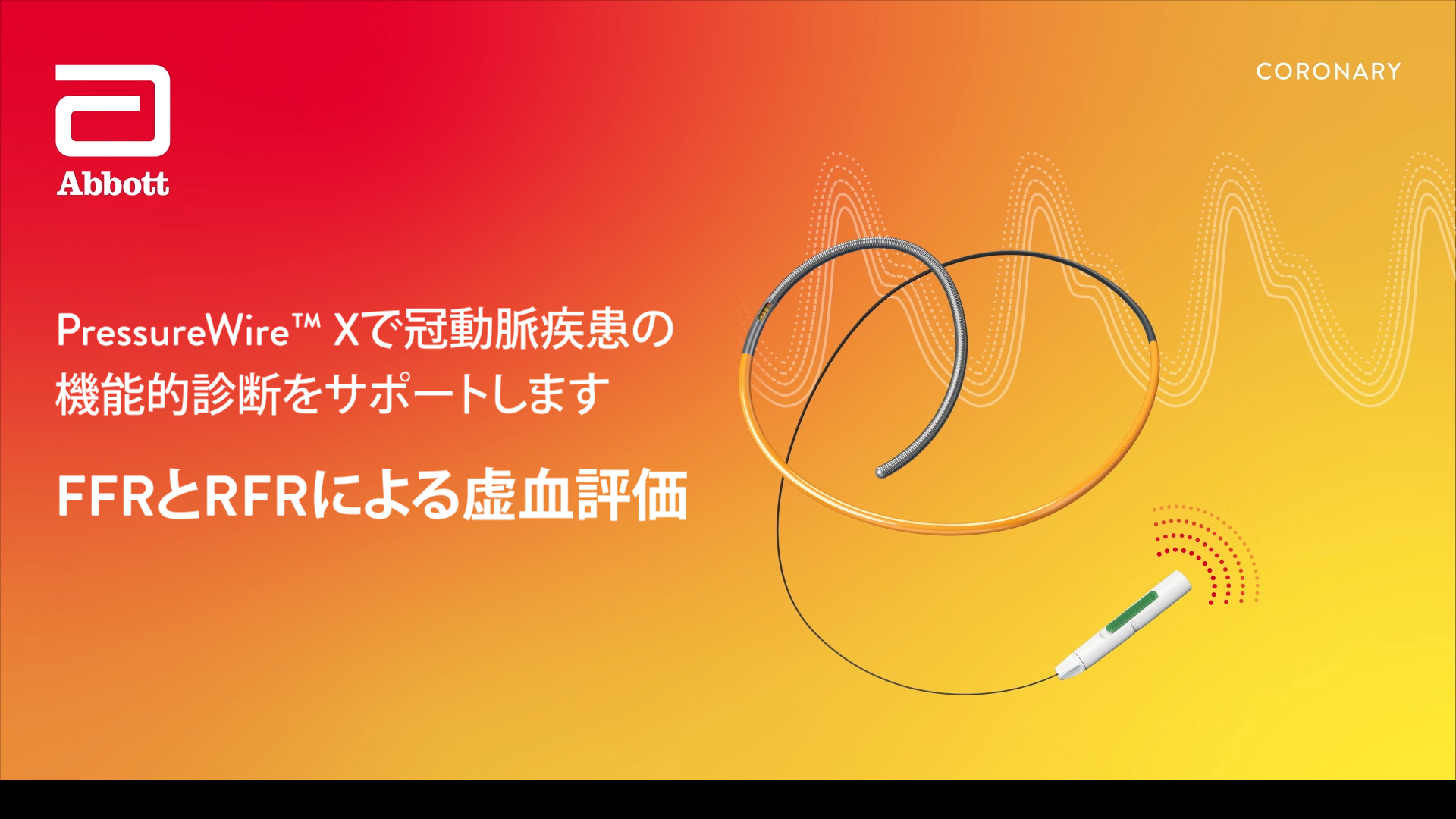生理学的指標を用いた評価が必要
血管造影による評価は、解剖学的な狭窄度の評価に限られており、血行動態を反映した生理学的な虚血の評価はできません。また、可視化の限界により、冠微小循環障害(CMD)の診断も十分にはできません1。
これが、学会のオピニオンリーダーやインターベンショニストの多くの方々が日常臨床において生理学的評価を採用/推奨する理由です。包括的な生理学的評価により、インターベンショニストは以下のために包括的な生理学的評価を行います。
- 血管造影だけでは不十分な機能的診断
- 心外膜病変の至適診療2.3
- より良い患者管理を実現するための冠微小循環障害の診断4
PressureWire™ X ガイドワイヤーは、心外膜疾患と冠微小循環障害の両方を評価する唯一のワイヤレスプレッシャーワイヤーです5.6。
生理学的指標の定義
心外膜疾患と冠微小循環障害の客観的診断
PressureWire™ Xを用いてFFR、RFRおよびCFR、IMRを測定する方法を見る
冠動脈全体の評価

Society Guidelines for Physiologic Indices
| 心外膜狭窄の診断 | 冠微小循環障害の診断 | ||||
|---|---|---|---|---|---|
| FFR | RFR | IMR | CFR | ||
| ガイドライン | ACC/SCAI (見る) CPT code (見る) | ESC Guideline 2019 (下表参照) | |||
| カットオフ値 (Defer / Nomal) | > 0.807 | > 0.898 | ≥ 2.04,* | < 254,* | |
| 計算式 | Pd/Pa | 全心周期におけるPd/Paの最小値 | 最大充血時流量/安静時流量 | Pd/最大充血時流量 | |
| 最大充血誘発 | 要 | 不要 | 要 | 要 | |
*IMR and CFR cutoffs in population of ischemia with no obstructive coronary artery disease (INOCA) patients, CorMicA trial1.
各指標の測定の詳細については、以下をご覧ください。
PressureWire™ Xガイドワイヤー:包括的機能評価をサポートする世界で唯一のワイヤレスプレッシャーガイドワイヤー6
圧センサーと温度センサーを備えたPressureWire™ X Guidewireは、冠動脈全体における包括的機能評価をサポートします5.6。
- 圧センサーを用いて、FFR、安静時Pd / Pa、およびRFRを測定します
- 温度センサーから得られる温度情報を用いた熱希釈法でCFRおよびIMRを測定します
PressureWire™ X Guidewireは、慢性冠症候群(CCS)および急性冠症候群(ACS)症例の両方で臨床的に広く活用されています10-12。

心外膜血管に対して、生理学的指標を用いて評価することにより、血管造影検査よりも多くの情報が得られるため、狭窄の重症度が層別化でき、インターベンションの可否判断にも役立ちます。
References
- Taqueti VR, Di Carli MF. Coronary microvascular disease pathogenic mechanisms and therapeutic options: JACC state-of-the-art review. J Am Coll Cardiol. 2018;72:2625-2641. doi:10.1016/j.jacc.2018.09.042.
- Pijls NH, de Bruyne B, Peels K, et al. Measurement of fractional flow reserve to assess the functional severity of coronary-artery stenoses. N Engl J Med. 1996;334(26):1703-1708.
- Xaplanteris P, Fournier S, Pijls NHJ, et al. Five-year outcomes with PCI guided by fractional flow reserve. N Engl J Med. 2018; 379:250-259.
- Ford TJ, Stanley B, Sidik N, et al. 1-year outcomes of angina management guided by invasive coronary function testing (CorMicA). J Am Coll Cardiol Intv. 2020;13:33-45
- Data on file at Abbott. Coroventis‡ CoroFlow‡ Cardiovascular System IFU.
- Volcano Corp. Verrata‡ guidewire and PrimeWire Prestige‡ Plus guidewire IFUs. Opsens Inc. OptoWire‡ guidewire and OptoWire‡ II guidewire IFUs. ACIST Medical Systems. Navvus‡ Microcatheter IFU. Boston Scientific Corporation. Comet‡ guidewire IFU. Abbott. PressureWire™ X guidewire IFU.
- Jeremias A, Kirtane AJ, Stone GW. A test in context: fractional flow reserve: accuracy, prognostic implications, and limitations. J Am Coll Cardiol. 2017;69(22):2748‐2758. doi:10.1016/j.jacc.2017.04.019.
- Kobayashi Y, Johnson NP, Zimmermann FM, et al. Agreement of the resting distal to aortic coronary pressure with the instantaneous wave-free ratio. J Am Coll Cardiol. 2017;70(17):2105‐2113. doi:10.1016/j.jacc.2017.08.049.
- Knuuti J, Wijns W, Saraste A, et al. 2019 ESC Guidelines for the diagnosis and management of chronic coronary syndromes: the Task Force for the diagnosis and management of chronic coronary syndromes of the European Society of Cardiology (ESC). Eur Heart J. 2020;41(3);407-477. doi: 10.1093/eurheartj/ehz425.
- Pijls NH, et al. Fractional flow reserve versus angiography for guiding percutaneous coronary intervention in patients with multivessel coronary artery disease: 2-year follow-up results of FAME study. J Am Coll Cardiol. 2010;56:177-184.
- Zimmermann FM, Ferrara A, Johnson NP, et al. 2015: Deferral vs. performance of percutaneous coronary intervention of functionally non-significant coronary stenosis: 15-year follow-up of the DEFER trial. Eur Heart J. 2015;36(45):3182-3188. doi:10.1093/eurheartj/ehv452.
- Smits PC, Abdel‑Wahab M, Neumann FJ, et al. Fractional flow reserve–guided multivessel angioplasty in myocardial infarction. N Engl J Med. 2017;376:1234-1244. doi: 10.1056/NEJMoa1701067.
- DEFER Bech GJW, De Bruyne B, Pijls NHJ, et al. Fractional flow reserve to determine the appropriateness of angioplasty in moderate coronary stenosis: a randomized trial. Circulation. 2001;103:2928-2934.
- FAME Tonino PA, De Bruyne B, Pijls NH, et al. Fractional flow reserve versus angiography for guiding percutaneous coronary intervention. N Engl J Med. 2009;360(3):213-224.
- 2010 ESC Wijns W, Kolh P, Danchin N, et al. Guidelines on myocardial revascularization: the Task Force on Myocardial Revascularization of the European Society of Cardiology (ESC) and the European Association for Cardio-Thoracic Surgery (EACTS). Eur Heart J. 2010;31(20):2501-2555.
- FAME 2 De Bruyne B, Pijls NHJ, Kalesan B, et al. Fractional flow reserve-guided PCI versus medical therapy in stable coronary disease. N Engl J Med. 2012;367:991-1001.
- RIPCORD Curzen N, Rana O, Nicholas Z, et al. Does routine pressure wire assessment influence management strategy at coronary angiography for diagnosis of chest pain: the RIPCORD study. Circ Cardiovasc Interv. 2014;7(2):248-255.
- R3F Van Belle E, Rioufol G, Pouillot C, et al. Outcome impact of coronary revascularization strategy reclassification with fractional flow reserve at time of diagnostic angiography: insights from a large French multicenter fractional flow reserve registry. Circulation. 2014;129(2):173-185.
- POST-IT Bravo Baptista S, Raposo L, Santos L, et al. Patterns of use and clinical utility of FFR in patients referred for coronary angiography: the POST-IT (POrtuguese Study on The Evaluation of FFR-guIded Treatment of coronary disease) prospective multicentre registry. EuroPCR 2014.
- FAME 3 Initiated Pijls NHJ, et al. A comparison of fractional flow reserve-guided percutaneous coronary intervention and coronary artery bypass graft surgery in patients with multivessel coronary artery disease (FAME 3). NCT02100722.
- FAMOUS-NSTEMI Layland J, Oldroyd KG, Curzen N, et al. Fractional flow reserve vs. angiography in guiding management to optimize outcomes in non-ST-segment elevation myocardial infarction: the British Heart Foundation FAMOUS–NSTEMI randomized trial. Eur Heart J. 2015;36(2):100-111.
- DANAMI-3—PRIMULTI Engstrøm T, Kelbæk H, Helqvist S, et al. Complete revascularisation versus treatment of the culprit lesion only in patients with ST-segment elevation myocardial infarction and multivessel disease (DANAMI-3—PRIMULTI): an open-label, randomised controlled trial. Lancet. 2015;386(9994):665-671.
- CONTRAST Nishi T, Johnson NP, De Bruyne B, et al. Influence of contrast media dose and osmolality on the diagnostic performance of contrast fractional flow reserve. Circ Cardiovasc Interv. 2017;10:e004985.
- PRIME-FFR Van Belle E, Baptista SB, Raposo L, et al. Impact of routine fractional flow reserve on management decision and 1-year clinical outcome of patients with acute coronary syndromes: PRIME-FFR (insights from the POST-IT [POrtuguese Study on The Evaluation of FFR-guIded Treatment of coronary disease] and R3F [French FFR Registry] Integrated MulticEnter registries - implementation of FFR [fractional flow reserve] in routine practice). Circ Cardiovasc Interv. 2017;10:e004296.
- FAME 2, 3-Year Data: Fearon WF, Nishi T, De Bruyne B, et al. Clinical outcomes and cost-effectiveness of fractional flow reserve–guided percutaneous coronary intervention in patients with stable coronary artery disease: three-year follow-up of the FAME 2 Trial. Circulation. 2018;137:480-487.
- Fame 2, 5-Year Data: Xaplanteris P, Fournier S, Pijls NHJ, et al. Five-year outcomes with PCI guided by fractional flow reserve. N Engl J Med. 2018; 379:250-259.
- FAME 3 2017-19: Zimmermann FM, De Bruyne B, Pijls NHJ, et al. A protocol update of the Fractional Flow Reserve versus Angiography for Multivessel Evaluation (FAME) 3 trial: A comparison of fractional flow reserve-guided percutaneous coronary intervention and coronary artery bypass graft surgery in patients with multivessel coronary artery disease. Am Heart J. 2019;214:156-157.
- GRAFFITI Toth GG, De Bruyne B, Kala P, et al. Graft patency after FFR-guided versus angiography-guided coronary artery bypass grafting: the GRAFFITI trial. EuroIntervention. 2019;15(11):e999-e1005.
- SAVE-IT Ramos R, Batista S, Raposo L, et al. Strategies for revascularization in patients undergoing heart valve surgery with concomitant coronary artery disease (SAVE-IT). NCT02173860.
- COMPARE ACUTE Smits PC, Abdel-Wahab M, Neumann FJ, et al, on behalf of the Compare-Acute Investigators. Fractional flow reserve–guided multivessel angioplasty in myocardial infarction. N Engl J Med. 2017;376:1234-1244.
- FLOWER MI Puymirat E, et al. FLOW Evaluation to guide Revascularization in multi-vessel ST-elevation Myocardial Infarction (FLOWER-MI). NCT02943954.
- FULL REVASC Bohm F, James S, Rück A, et al. Ffr-gUidance for compLete Non-cuLprit REVASCularization (FULL REVASC). NCT02862119.
- FFR Global Registry Schampaert E, Kumar G, Achenbach S, et al. A global registry of fractional flow reserve (FFR)-guided management during routine care: study design, baseline characteristics and outcomes of invasive management. Catheter Cardiovasc Interv. Published online ahead of print, March 14, 2020.
- VALIDATE-RFR Svanerud J, Ahn JM, Jeremias A, et al. Validation of a novel non-hyperaemic index of coronary artery stenosis severity: the Resting Full-cycle Ratio (VALIDATE RFR) study. EuroIntervention. 2018; 14:806-814.
- D.J. Maron, J.S. Hochman, et al. Initial Invasive or Conservative Strategy for Stable Coronary Disease.New England Journal of Medicine April 3, 2020
- Sebastian Völz, MD, Christian Dworeck, et al. Survival of Patients With Angina Pectoris Undergoing Percutaneous Coronary Intervention With Intracoronary Pressure Wire Guidance.J Am Coll Cardiol 2020;75:2785–99
- Tadashi Murai , MD; Valerie E, et al. Coronary Flow Capacity to Identify Stenosis Associated With Coronary Flow Improvement After Revascularization: A Combined Analysis From DEFINE FLOW and IDEAL.J Am Heart Assoc. 2020;9:e016130
- Thomas J. Ford, Bethany Stanley, et al. 1-Year Outcomes of Angina Management Guided by Invasive Coronary Function Testing (CorMicA).J Am Coll Cardiol Intv 2020;13:33–45
- Stephane Fournier, Carlos Collet, et al. Global Fractional Flow Reserve Value Predicts 5-Year Outcomes in Patients With Coronary Atherosclerosis But Without Ischemia.J Am Heart Assoc. 2020;9:e017729
- Seong-Mi Park, Janet Wei, et al. Left ventricular concentric remodelling and functional impairment in women with ischaemia with no obstructive coronary artery disease and intermediate coronary flow reserve: a report from the WISE-CVD Study.European Heart Journal - Cardiovascular Imaging (2019) 20, 875–882
- Kazunori Horie, MD; Shoichi Kuramitsu, et al. Two-Year Outcomes of Asymptomatic vs. Symptomatic Patients After Deferral of Revascularization Based on Fractional Flow Reserve.Circ Rep 2020; 2: 744–752
- Stephane Fournier, Gabor G Toth, et al. Changes in surgical revascularization strategy after fractional flow reserve. Catheter Cardiovasc Interv. 2021;1–5
- Etienne Puymirat, Guillaume Cayla, et al. Multivessel PCI Guided by FFR or Angiography for Myocardial Infarction. NEJM2021 2104650
- Damien Collison, Matthaios Didagelos, et al. Post-stenting fractional flow reserve vs coronary angiography for optimization of percutaneous coronary intervention (TARGET-FFR).European Heart Journal (2021) 42, 4656–4668
- Hiroaki Shimokawa, Akira Suda, et al. Clinical characteristics and prognosis of patients with microvascular angina: an international and prospective cohort study by the Coronary Vasomotor Disorders International Study (COVADIS) Group.European Heart Journal (2021) 00, 1–9
- W.F. Fearon, F.M. Zimmermann, et al. Fractional Flow Reserve–Guided PCI as Compared with Coronary Bypass Surgery. NEJM 2021:2112299
- Bo Xu, Shengxian Tu, et al. Angiographic quantitative flow ratio-guided coronary intervention (FAVOR III China).LANCET 2021; 140-6736(21)02248
- Yasutsugu Shiono, Hitoshi Matsuo, et al. Diagnostic Accuracy of Diastolic Fractional Flow Reserve for Functional Evaluation of Coronary Stenosis DIASTOLE Study. JACC: Asia 2021;1:230–241
- Eileen M. Handberg, C. Noel Bairey Merz, et al. Rationale and design of the Women’s Ischemia Trial to Reduce Events in Nonobstructive CAD (WARRIOR) trial. Am Heart J 2021;237:90–103
- Seung Hun Lee; Doosup Shin, et al. Clinical Relevance of Ischemia with Nonobstructive Coronary Arteries According to Coronary Microvascular Dysfunction. J Am Heart Assoc. 2022;11:e025171
- Harmony R. Reynolds; Akiko Maehara, et al. Coronary Optical Coherence Tomography and Cardiac Magnetic Resonance Imaging to Determine Underlying Causes of Myocardial Infarction With Nonobstructive Coronary Arteries in Women. Circulation. 2021;143:624–640
- B.-K. Koo, X. Hu, J. Kang, et al. Fractional Flow Reserve or Intravascular Ultrasonography to Guide PCI. N Engl J Med 2022;387:779-89
MAT-2304623 v1.0




